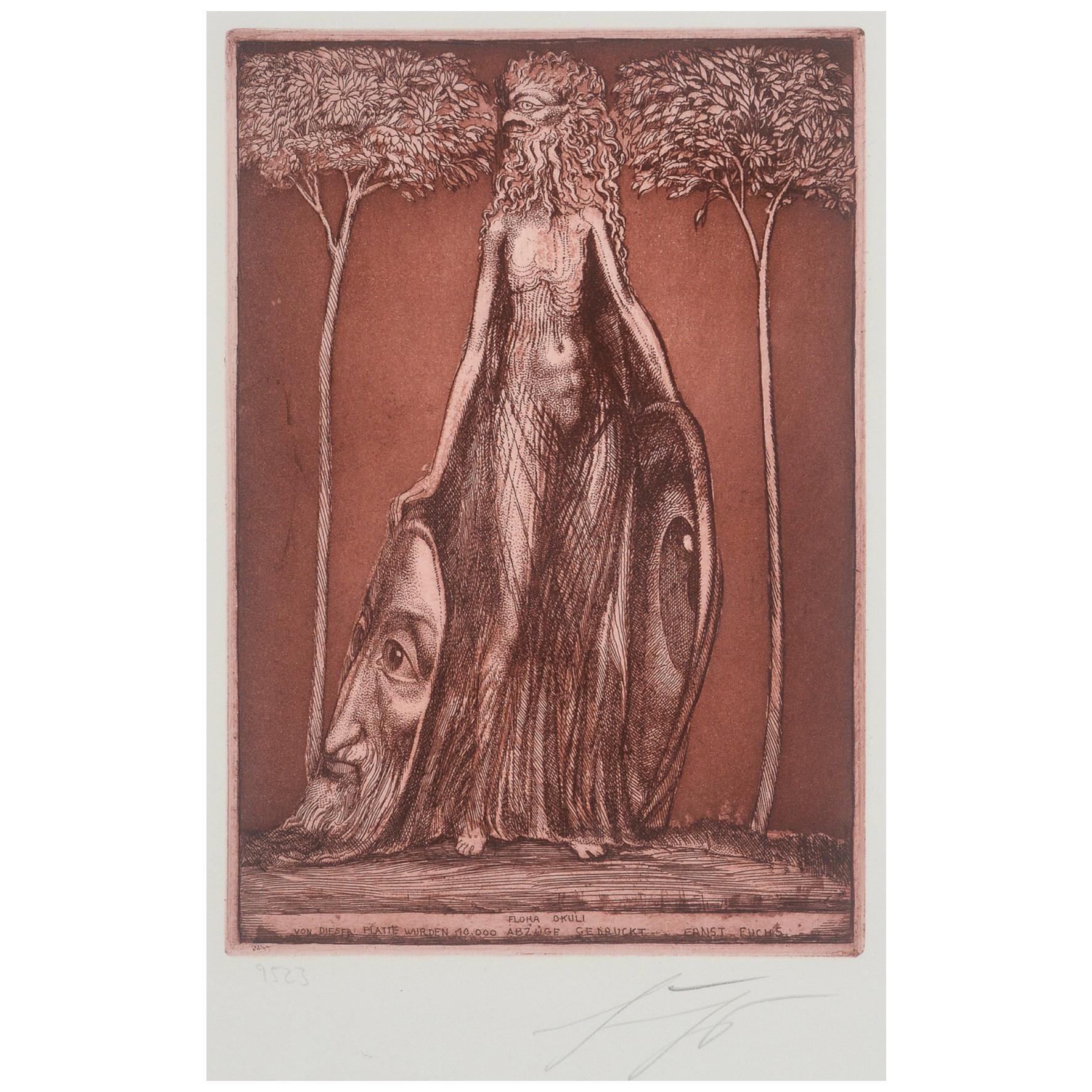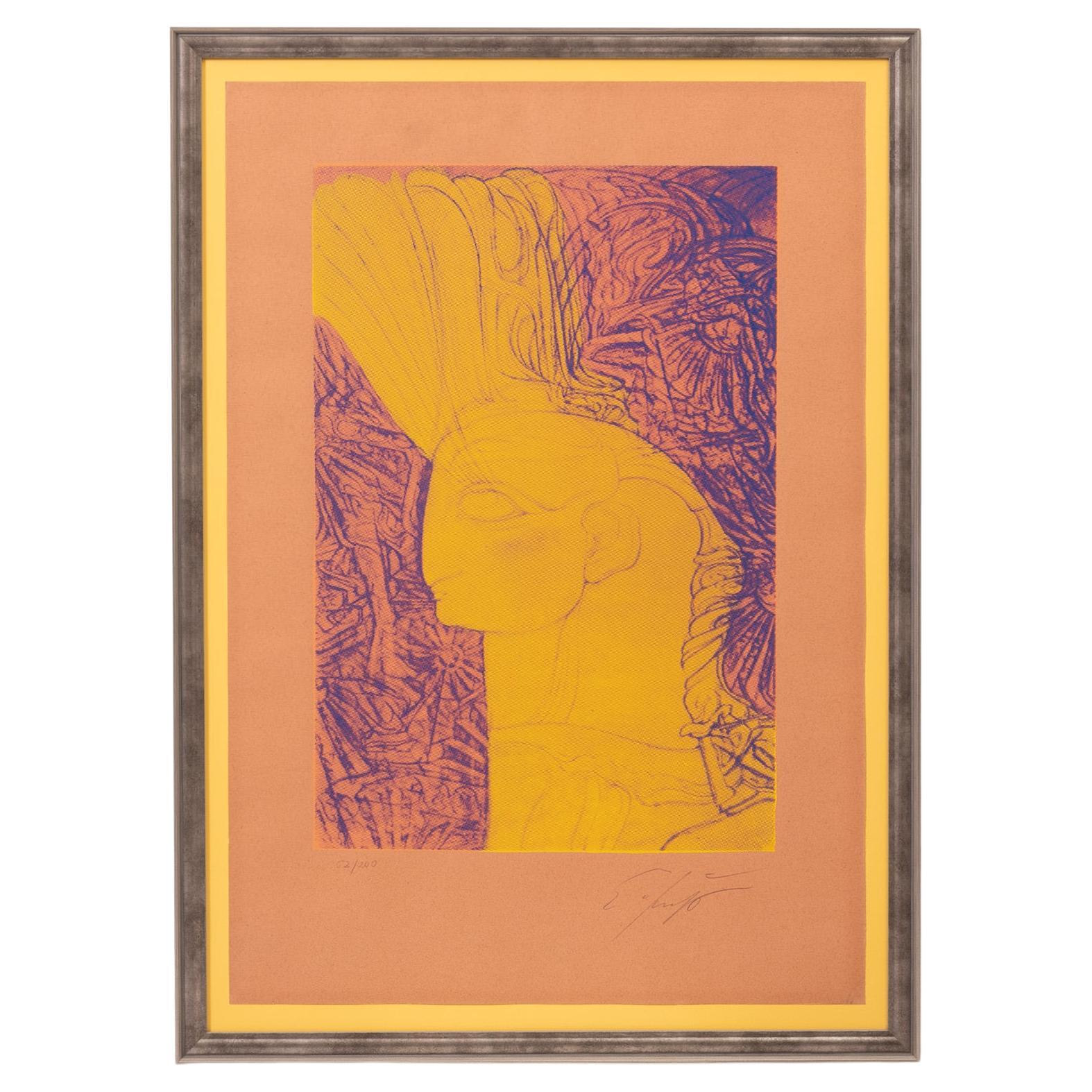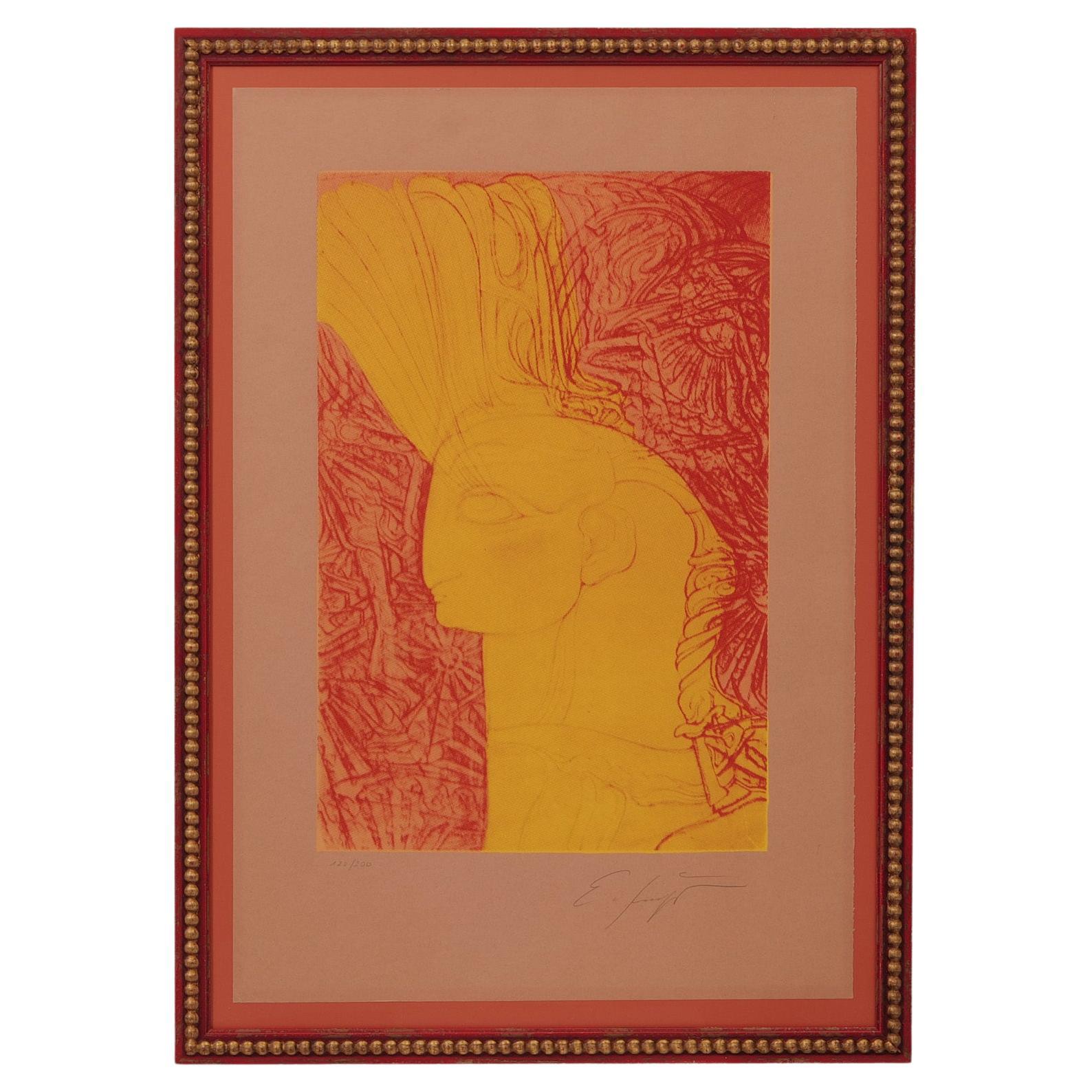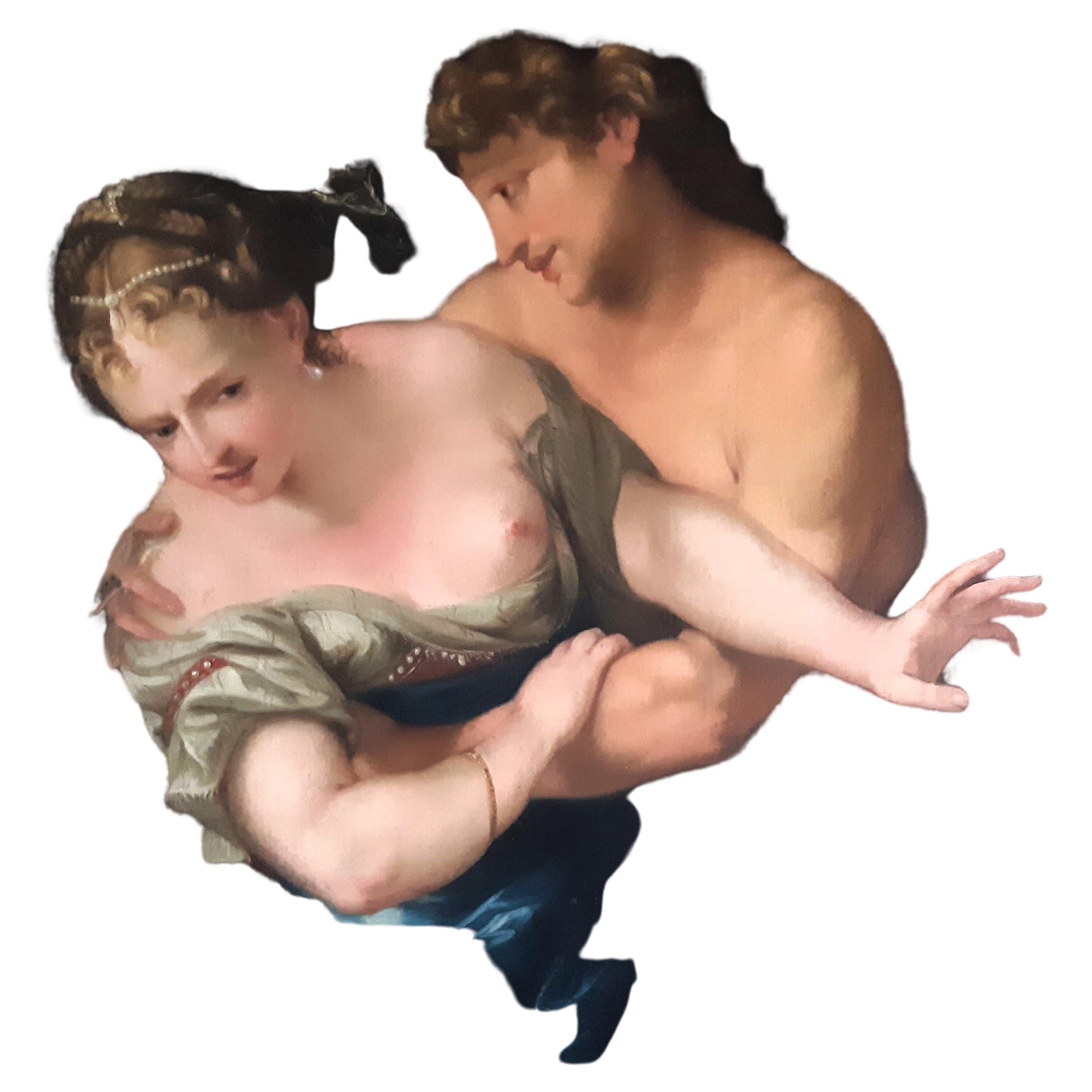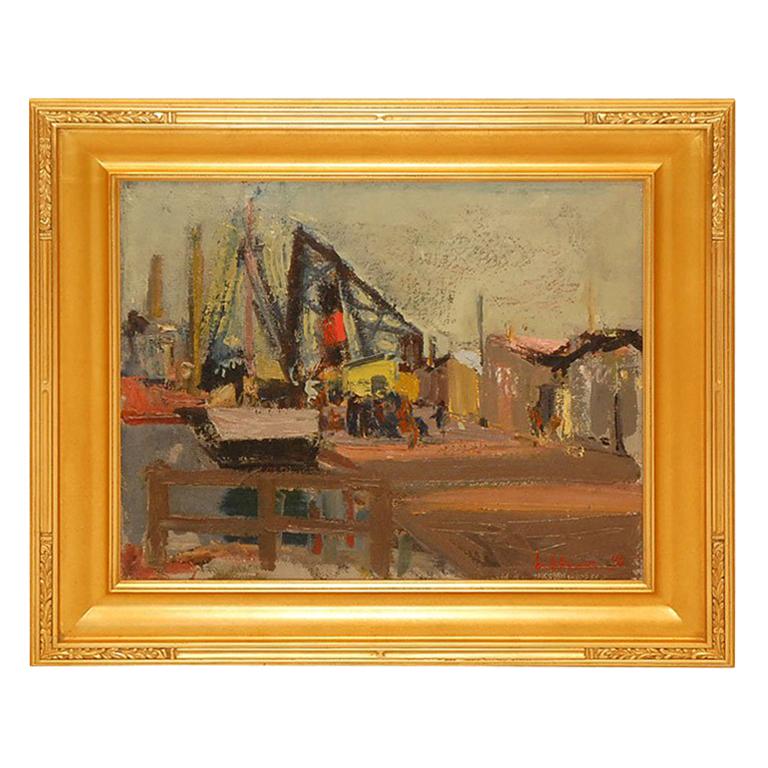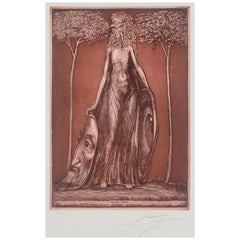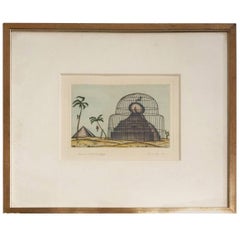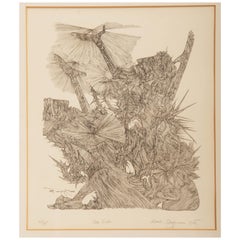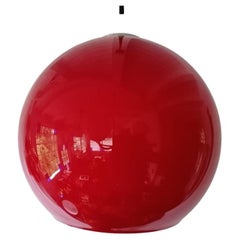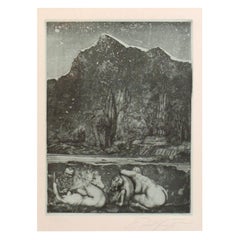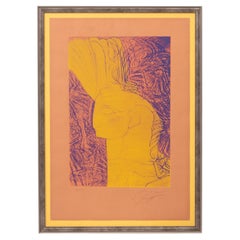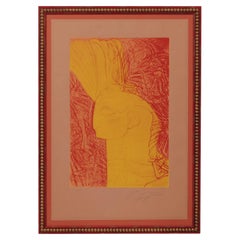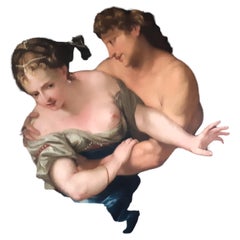Items Similar to Ernst Fuchs "Jakob Und Joseph" Etching, 1976
Want more images or videos?
Request additional images or videos from the seller
1 of 5
Ernst Fuchs "Jakob Und Joseph" Etching, 1976
About the Item
Ernst Fuchs
"Jacob and Joseph"
etching
Hand signed, numbered, 1763/3000
Edition 3000 copies.
Format of display:
18.5 x 16.5cm, on handmade paper 29 x 24cm in glued in passepartout 40 x 30cm.
- Creator:Ernst Fuchs (Artist)
- Dimensions:Height: 16.93 in (43 cm)Width: 16.93 in (43 cm)Depth: 0.79 in (2 cm)
- Materials and Techniques:
- Place of Origin:
- Period:
- Date of Manufacture:1976
- Condition:
- Seller Location:Vienna, AT
- Reference Number:1stDibs: LU117428083643
Ernst Fuchs
Ernst Fuchs was a very poliedric artist. He was a painter, draftsman, printmaker, sculptor, architect, stage designer, composer, poet, singer and one of the founders of the Vienna School of Fantastic Realism. In 1972, he acquired the derelict Otto Wagner Villa in Hütteldorf, which he restored and transformed. The villa was inaugurated as the Ernst Fuchs Museum in 1988.
About the Seller
4.4
Gold Seller
Premium sellers maintaining a 4.3+ rating and 24-hour response times
Established in 2013
1stDibs seller since 2015
1,526 sales on 1stDibs
Typical response time: <1 hour
- ShippingRetrieving quote...Shipping from: Vienna, Austria
- Return Policy
Authenticity Guarantee
In the unlikely event there’s an issue with an item’s authenticity, contact us within 1 year for a full refund. DetailsMoney-Back Guarantee
If your item is not as described, is damaged in transit, or does not arrive, contact us within 7 days for a full refund. Details24-Hour Cancellation
You have a 24-hour grace period in which to reconsider your purchase, with no questions asked.Vetted Professional Sellers
Our world-class sellers must adhere to strict standards for service and quality, maintaining the integrity of our listings.Price-Match Guarantee
If you find that a seller listed the same item for a lower price elsewhere, we’ll match it.Trusted Global Delivery
Our best-in-class carrier network provides specialized shipping options worldwide, including custom delivery.More From This Seller
View AllErnst Fuchs Etching Flora Okuli
By Ernst Fuchs
Located in Vienna, AT
Ernst Fuchs "Flora Okuli"
Etching on handmade paper number 9523/10000, sign. Measures: 24 x 16.5 (43 x 31.5) cm.
Category
Vintage 1960s Austrian Prints
Arnold Leissler Etchings
Located in Vienna, AT
Arnold Leissler
Southern impressions from journeys, 1975
Color etchings in colours and one etching on handmade paper
17 cm x 20 cm (picture only)
S...
Category
Vintage 1970s German Paintings
Materials
Paper
Ernst Degasperi Etching "Zum Licht"
Located in Vienna, AT
Ernst Degasperi Etching "Zum LIcht" Number 43/65 from 1972.
Print only 30 x 35cm
Aluminum frame with glass front.
Category
Antique Early 1900s Austrian Prints
Materials
Paper
Pendant Lamp by Peil Und Putzler
By Peill & Putzler
Located in Vienna, AT
Peil und Putzler glass pendant lamp from the 1970s.
Category
Vintage 1970s German Mid-Century Modern Chandeliers and Pendants
Materials
Art Glass
Wolfgang Glechner Oil on Canvas "Cycling Tour"
Located in Vienna, AT
Oil on canvas 30x40cm
created 2015
Wolfgang Glechner was born in 1951 in Braunau am Inn.
He is an autodidact.
Since 1998 (according to his own developed "separation color theory") strongly colored paintings in oil and acrylic.
Years ago he started as an working as an lllustrator, working primarily black and white pen and ink drawings...
Category
2010s Austrian Paintings
Materials
Canvas
Wolfgang Glechner Oil on Canvas "Women Bathing at the Gravel Pond"
Located in Vienna, AT
Oil on canvas 50x60cm
created 2014
Wolfgang Glechner was born in 1951 in Braunau am Inn.
He is an autodidact.
Since 1998 (according to his own developed "separation color theory") strongly colored paintings in oil and acrylic.
Years ago he started as an working as an llustrator, working primarily black and white pen and ink drawings...
Category
2010s Austrian Contemporary Art
Materials
Canvas
You May Also Like
Ernst Fuchs 'Under the Snow Lilith' Print, 1969
By Ernst Fuchs
Located in Los Angeles, CA
Surreal dry point etching, 'Under the Snow Lilith' by Ernst Fuchs, signed lower left, right, numbered '27/150,' mounted and framed, panel size: 10.5" x 13.5" (without frame).
Category
Vintage 1960s German Mid-Century Modern Prints
Materials
Paper
Ernst Fuchs (1930 - 2015) "Head of a cherub", created in 1982 Color silkscreen
By Ernst Fuchs
Located in Münster, DE
Ernst Fuchs (1930 - 2015)
"Head of a cherub", created in 1982
Color silkscreen, ed. 200 pieces, signed and numbered
Dimensions 67.7 cm x 45 cm
Ernst Fuchs was born on February 13, 1930 in Vienna Ottakring as the only child of Maximilian and Leopoldine Fuchs; his father was of Jewish descent, which is why his grandfather and father emigrated to the USA and Shanghai in 1938 after the annexation of Austria by the Third Reich. To protect little Ernst from anti-Semitic hostility, it was decided to baptize him according to the Roman Catholic rite in 1942. The 12-year-old Ernst Fuchs was allowed to choose his own baptismal name and chose Ernst Peter Paul, in honor of the painter Peter Paul Rubens, whom he admired at the time. Around the same time, his godmother's brother, the painter and restorer Alois Schiemann, taught him the basics of drawing and painting. Until the age of 15, he attended the St. Anna painting school in Vienna, where he was taught sculpture and painting by Emmy Steinböck and Fritz Fröhlich.
After the war, Ernst Fuchs was finally able to take up his longed-for studies at the Academy of Fine Arts in Vienna, which he had previously been denied for racist reasons. His teachers were first Robin Andersen, then Albert Paris Gütersloh. While still a student, he was allowed to hold his first solo exhibition in Paris in 1949, and soon afterwards, in 1950, he also moved to the French capital. Ernst Fuchst traveled through Europe and the USA for six years before taking an extended stay at the Dormition Monastery on Mount Zion in Israel in 1957 to study icon painting in depth. He finally returned to Vienna in 1962, where he founded the Vienna School of Fantastic Realism with former fellow students, of which he himself was to become the most important representative. The early years in particular were characterized by a strong surrealism; mythical and religious symbols in particular appealed to Ernst Fuchs and permeated his work. Later, Fuchs turned increasingly to Mannerism.
Ernst Fuchs' artistic spectrum broadened over the years: he sang and recorded various albums, which, like the majority of his paintings, were inspired by mystical motifs, and he designed stage sets for such famous operas as Wagner's Parsifal and Lohengrin or Mozart's Die Zauberflöte. Ernst Fuchs also wrote philosophical treatises. He repeatedly collaborated with other artists, including the musicians Klaus Schulze...
Category
Vintage 1980s Austrian Modern Contemporary Art
Materials
Paper
Ernst Fuchs (1930 - 2015) "Head of a cherub", created in 1982 Color silkscreen
By Ernst Fuchs
Located in Münster, DE
Ernst Fuchs (1930 - 2015)
"Head of a cherub", created in 1982
Color silkscreen, ed. 200 pieces, signed and numbered
Dimensions 67.7 cm x 45 cm
Ernst Fuchs was born on February 13, 1930 in Vienna Ottakring as the only child of Maximilian and Leopoldine Fuchs; his father was of Jewish descent, which is why his grandfather and father emigrated to the USA and Shanghai in 1938 after the annexation of Austria by the Third Reich. To protect little Ernst from anti-Semitic hostility, it was decided to baptize him according to the Roman Catholic rite in 1942. The 12-year-old Ernst Fuchs was allowed to choose his own baptismal name and chose Ernst Peter Paul, in honor of the painter Peter Paul Rubens, whom he admired at the time. Around the same time, his godmother's brother, the painter and restorer Alois Schiemann, taught him the basics of drawing and painting. Until the age of 15, he attended the St. Anna painting school in Vienna, where he was taught sculpture and painting by Emmy Steinböck and Fritz Fröhlich.
After the war, Ernst Fuchs was finally able to take up his longed-for studies at the Academy of Fine Arts in Vienna, which he had previously been denied for racist reasons. His teachers were first Robin Andersen, then Albert Paris Gütersloh. While still a student, he was allowed to hold his first solo exhibition in Paris in 1949, and soon afterwards, in 1950, he also moved to the French capital. Ernst Fuchst traveled through Europe and the USA for six years before taking an extended stay at the Dormition Monastery on Mount Zion in Israel in 1957 to study icon painting in depth. He finally returned to Vienna in 1962, where he founded the Vienna School of Fantastic Realism with former fellow students, of which he himself was to become the most important representative. The early years in particular were characterized by a strong surrealism; mythical and religious symbols in particular appealed to Ernst Fuchs and permeated his work. Later, Fuchs turned increasingly to Mannerism.
Ernst Fuchs' artistic spectrum broadened over the years: he sang and recorded various albums, which, like the majority of his paintings, were inspired by mystical motifs, and he designed stage sets for such famous operas as Wagner's Parsifal and Lohengrin or Mozart's Die Zauberflöte. Ernst Fuchs also wrote philosophical treatises. He repeatedly collaborated with other artists, including the musicians Klaus Schulze...
Category
Vintage 1980s Austrian Modern Contemporary Art
Materials
Paper
Erotisches Ölgemälde , 18. Jahrhundert "Amymon und Satyr"
Located in Aachen, DE
Ölgemälde auf Leinwand, doubliert, im Stil der Lombardischen Schule, 18. Jahrhundert
Das Gemälde ist betitelt: "Amymon wehrt sich gegen die Annäherungsversuche eines Satyrs".
Es ha...
Category
Antique Late 18th Century Paintings
Materials
Canvas
Oil Painting by Ernst Rasmussen
By Ernst Rasmussen
Located in Los Angeles, CA
Oil painting by well listed artist Ernst Rasmussen(1912-1964) The painting is painted on canvas and dated "46". Store formerly known as ARTFUL DODGE...
Category
Vintage 1940s Danish Scandinavian Modern Paintings
Materials
Canvas, Wood
$960 Sale Price
40% Off
Charles Joseph Watelet
By Charles Joseph Watelet
Located in Belmont, MA
Charles Joseph Watelet (Belgian painter 1867-1954),
Portrait of a young woman called Daisy, oil on canvas. Framed in a beautiful hand carved giltwood frame.
Category
Early 20th Century Belgian Art Deco Paintings
Materials
Canvas
$3,200
